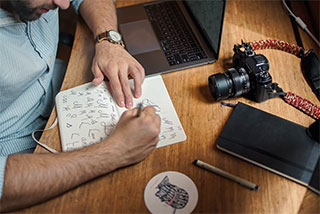SALES / SUPPORT : 844-232-4816
Does Your Logo Design Possess These 5 Characteristics?
What’s in a logo? A company name without any embellishment would work just as well — right?
Well, even without badly paraphrasing Shakespeare, those questions could lead to a great deal of contention in the design world. It’s possible to create a logo that is functional without necessarily creating one that is effective.
In other words, you can slap a piece of graphic design on a business card and correctly identify the business. But that shouldn’t be all that a logo does.
A logo is more than just an identifying mark. It’s a fundamental piece of branding. It goes deeper than the visuals and speaks to the message at the heart of the brand.
According to Zaheer Dodhia, CEO and Founder of LogoDesign.Net, “Your brand identity starts with a logo. If you can get a memorable, unique and identifiable logo design for your startup then you have taken the first step towards building a brand for the long term.”
The elements that make up a logo — type of logo, font choice, color, graphic style, and everything else — are less important on an individual level than they are when taken together as a harmonious and vital piece of branding, one that will be used thousands of times, in thousands of situations, to appeal to thousands of potential customers.
That’s a big job for a little piece of graphic design. How can logo designers ensure that their creation can steadily shoulder the responsibility of the brand?
Here are five characteristics to make sure you include before you release your logo design out into the world.
- Clarity
- Balance
- Focus
- Impact
- Versatility
Clarity
The clarity of a piece of design comes from two important factors:
- Accuracy of messaging
- Accuracy of delivery
A great logo design serves as a representative of the brand as a whole. So accurate messaging needs to reflect the personality of the brand. This is a big part of why researching the competition and understanding the values, purposes, and goals of the brand are so important prior to crafting a logo.
If your client company hasn’t presented you with a creative brief — ask for one. If they say, “But it’s just a logo,” then say, “Yes, exactly. It’s a logo design. The ambassador for your entire brand.”
Brand personality is a non-negotiable factor in logo design. It’s really impossible to create an accurate logo if you know nothing about the brand it will represent.
As an example of how every design choice can accurately reflect both the brand and the audience, take a look at this branding for Malyatko, which creates children’s education products and is targeted at families with toddlers.
It’s hard to find a more accurate way to express the personality behind the brand and the audience it is trying to reach at the same time, and every aspect of the branding works toward the same goal.
As you go through the design process, check your chosen elements against the creative brief and what you understand about the brand.
The second half of this characteristic, accuracy of delivery, is more about the technical aspect of logo design. To deliver your messaging accurately, ensure that your design choices are clear and easy to understand. Your font must be legible. Your graphic style shouldn’t be so complicated that it takes too long to grasp, or so simple that it’s impossible to know for sure what it’s meant to represent. Your colors must show well against each other, and details must not get lost in the shuffle.
This is a simple, clear example of how to blend color choice and font choice in a way that promotes accuracy of messaging. Both parts of this combination logo design — the font and the abstract graphic — fit well together and send the same message. Harmony between every element means that the message of the logo won’t get lost.
The upshot? Your logo needs to deliver a message about the brand, and it needs to be clear and understandable in order to ensure its efficacy.
- Physicians Office Logos
- Church Logos
- Factory Logos
- Bar Logos
- Bed & Breakfast Logos
- Beauty School Logos
- Grocery Shop Logos
- Business Logos
- Physical Therapy Logos
Balance
Symmetry in design in design is important. Not only does symmetry tend to be more appealing to us, but an unbalanced composition can actually lead to the viewer feeling overwhelmed.. A lack of symmetry creates a chaotic feeling in graphic design.
Of course, any good logo designer knows that this doesn’t mean that everything has to be a mirror-image down the middle. Good balance requires a careful placement of elements that reflects the principles of good design, including choice of alignment and use of space.
Balance can only truly be achieved by incorporating all elements of the logo, from graphic to font to negative space. As you work through the design of your logo, remember that each individual element needs to fit seamlessly into the bigger picture.
Focus
Statistics indicate that we form our first impressions in less than one tenth of a second. We make up our minds very quickly how we feel about what we’re looking at.
That means that your logo design needs to make a great impression at what amounts to lightspeed.
In order for that to happen, the design needs to make the focal point of the logo clear. Whether that’s a graphic or a word, it needs to be front and center.
But focus isn’t just a matter of centering the main element of your design. Every other element needs to play a supporting role and lead the eye to that focal point.

Source: LogoDesign.Net
Hierarchy is an important tool in creating a focal point. Use hierarchy in color, size, spacing, or weight to push your main element to the fore. For example, you could use variations on the same color but with different levels of opacity to make a single element stand out amid
repetitions. Or the focal point of your logo design could be delivered in a heavier typeface than the other information, such as in the case of a combination mark that uses a lettermark in addition to the company name fully spelled out.
Employing hierarchy to create focus within your logo design is an excellent way to make the logo more dynamic, which also boosts the memorability and overall effectiveness of the design.
Impact
Speaking of designing dynamic logos, “impact” is another characteristic that your logo must possess.
Impact is created through the use of the principles of good design, such as balance, focus, and contrast. It is also assisted through excellent messaging and adherence to brand personality.
But impact also owes its effectiveness to an awareness of surroundings. Simply put, if your logo looks too much like other logos, it will lose impact. If it’s too “on-trend” without a purpose, it will lose impact. If it’s not designed for its market, it will lose impact. And if the elements blend together indiscernibly, you guessed it — it will lose impact.
Impact is carried on a variety of levels — visual, technical, and emotional. As such, it invites the viewer to create a connection with the design.
If your logo design doesn’t make the viewer want to look twice, you may need to consider making some big adjustments.
- Optometry Logos
- Driving School Logos
- Recruiting Logos
- HVAC Logos
- Chiropractic Logos
- Video Production Logos
- Telemarketing Logos
- Fundraiser Logos
- Pest Control Logos
Versatility
A final, but no less important, key characteristic that your logo must possess is versatility.
Logos are designed to be used everywhere. Anywhere that the brand has to go, the logo must go. Business cards, promotional products, packaging, advertising, websites, print and digital marketing, billboards, buses — there’s no limit to where a well-designed logo will be used.
So it really needs to be limitlessly versatile.
A few important factors to ensure versatility:
- Type of file. Logos should be vector images in order to ensure that they can be shrunk down or blown up without losing clarity.
- Colors. Check what your logo design looks like with a limited color palette, or if some of the colors don’t show true. Make sure that there is enough contrast between colors that your design details won’t be lost.
- Black and white. It’s a good idea to run tests to see how your logo shows up in grayscale and black and white.
- Bordered. To keep your logo from blending in to the background, incorporate a border. Even if it’s just a narrow line, it will make a big difference in the visibility of your logo.
Inspiration For Effective Logos
There are no perfect logo designers. Every designer is at a certain point in their personal journey of education on how to be a better designer. There’s a reason why most experts encourage new designers to look for inspiration — from famous logos to sites like Behance, LogoLounge, Dribbble and Deviantart — in order to help them learn what works...and what doesn’t.
In the end, there are a hundred different factors that play into whether a logo design is effective for a brand or not. But these five characteristics are absolutely vital to help you create a design that is not only appealing and well-designed, but truly memorable and unique.
- Dj Logos
- Director Logos
- Teacher Logos
- Building Logos
- Elementary School Logos
- Acupuncturist Logos
- Car Wash Logos
- Babysitter Logos
- Nail Spa Logos
